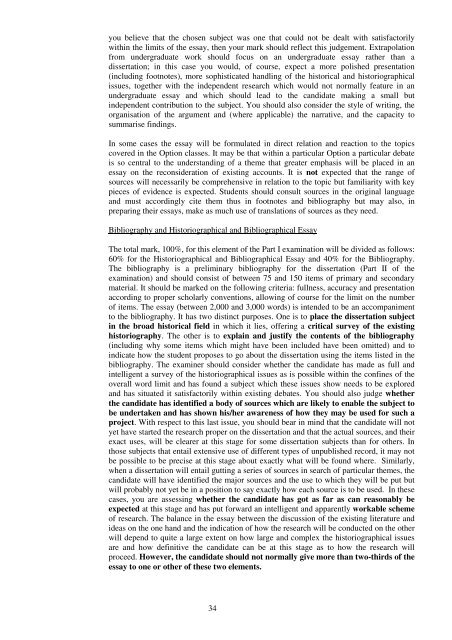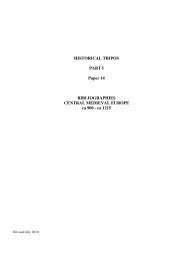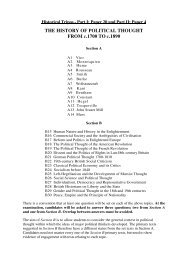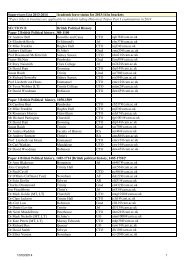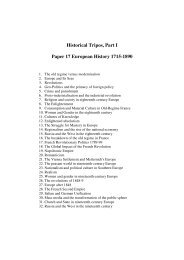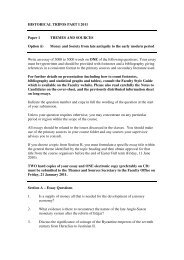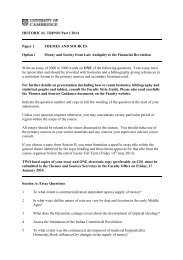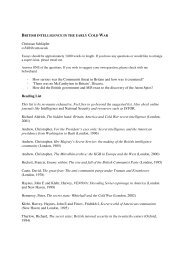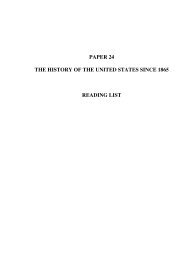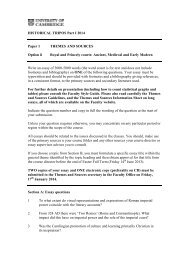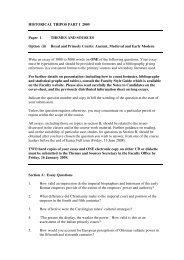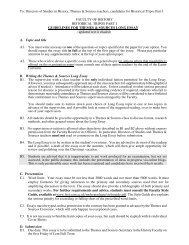Course Handbook - Faculty of History
Course Handbook - Faculty of History
Course Handbook - Faculty of History
Create successful ePaper yourself
Turn your PDF publications into a flip-book with our unique Google optimized e-Paper software.
you believe that the chosen subject was one that could not be dealt with satisfactorily<br />
within the limits <strong>of</strong> the essay, then your mark should reflect this judgement. Extrapolation<br />
from undergraduate work should focus on an undergraduate essay rather than a<br />
dissertation; in this case you would, <strong>of</strong> course, expect a more polished presentation<br />
(including footnotes), more sophisticated handling <strong>of</strong> the historical and historiographical<br />
issues, together with the independent research which would not normally feature in an<br />
undergraduate essay and which should lead to the candidate making a small but<br />
independent contribution to the subject. You should also consider the style <strong>of</strong> writing, the<br />
organisation <strong>of</strong> the argument and (where applicable) the narrative, and the capacity to<br />
summarise findings.<br />
In some cases the essay will be formulated in direct relation and reaction to the topics<br />
covered in the Option classes. It may be that within a particular Option a particular debate<br />
is so central to the understanding <strong>of</strong> a theme that greater emphasis will be placed in an<br />
essay on the reconsideration <strong>of</strong> existing accounts. It is not expected that the range <strong>of</strong><br />
sources will necessarily be comprehensive in relation to the topic but familiarity with key<br />
pieces <strong>of</strong> evidence is expected. Students should consult sources in the original language<br />
and must accordingly cite them thus in footnotes and bibliography but may also, in<br />
preparing their essays, make as much use <strong>of</strong> translations <strong>of</strong> sources as they need.<br />
Bibliography and Historiographical and Bibliographical Essay<br />
The total mark, 100%, for this element <strong>of</strong> the Part I examination will be divided as follows:<br />
60% for the Historiographical and Bibliographical Essay and 40% for the Bibliography.<br />
The bibliography is a preliminary bibliography for the dissertation (Part II <strong>of</strong> the<br />
examination) and should consist <strong>of</strong> between 75 and 150 items <strong>of</strong> primary and secondary<br />
material. It should be marked on the following criteria: fullness, accuracy and presentation<br />
according to proper scholarly conventions, allowing <strong>of</strong> course for the limit on the number<br />
<strong>of</strong> items. The essay (between 2,000 and 3,000 words) is intended to be an accompaniment<br />
to the bibliography. It has two distinct purposes. One is to place the dissertation subject<br />
in the broad historical field in which it lies, <strong>of</strong>fering a critical survey <strong>of</strong> the existing<br />
historiography. The other is to explain and justify the contents <strong>of</strong> the bibliography<br />
(including why some items which might have been included have been omitted) and to<br />
indicate how the student proposes to go about the dissertation using the items listed in the<br />
bibliography. The examiner should consider whether the candidate has made as full and<br />
intelligent a survey <strong>of</strong> the historiographical issues as is possible within the confines <strong>of</strong> the<br />
overall word limit and has found a subject which these issues show needs to be explored<br />
and has situated it satisfactorily within existing debates. You should also judge whether<br />
the candidate has identified a body <strong>of</strong> sources which are likely to enable the subject to<br />
be undertaken and has shown his/her awareness <strong>of</strong> how they may be used for such a<br />
project. With respect to this last issue, you should bear in mind that the candidate will not<br />
yet have started the research proper on the dissertation and that the actual sources, and their<br />
exact uses, will be clearer at this stage for some dissertation subjects than for others. In<br />
those subjects that entail extensive use <strong>of</strong> different types <strong>of</strong> unpublished record, it may not<br />
be possible to be precise at this stage about exactly what will be found where. Similarly,<br />
when a dissertation will entail gutting a series <strong>of</strong> sources in search <strong>of</strong> particular themes, the<br />
candidate will have identified the major sources and the use to which they will be put but<br />
will probably not yet be in a position to say exactly how each source is to be used. In these<br />
cases, you are assessing whether the candidate has got as far as can reasonably be<br />
expected at this stage and has put forward an intelligent and apparently workable scheme<br />
<strong>of</strong> research. The balance in the essay between the discussion <strong>of</strong> the existing literature and<br />
ideas on the one hand and the indication <strong>of</strong> how the research will be conducted on the other<br />
will depend to quite a large extent on how large and complex the historiographical issues<br />
are and how definitive the candidate can be at this stage as to how the research will<br />
proceed. However, the candidate should not normally give more than two-thirds <strong>of</strong> the<br />
essay to one or other <strong>of</strong> these two elements.<br />
34


